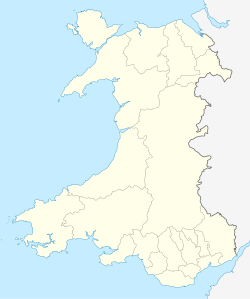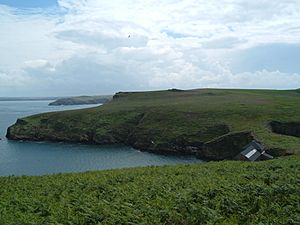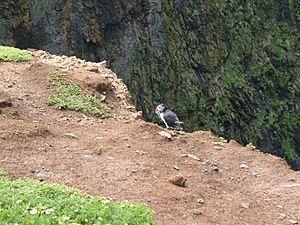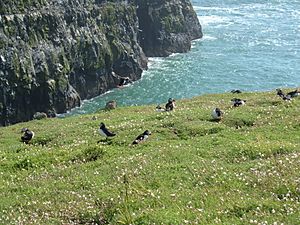Skomer facts for kids
|
Native name:
Ynys Sgomer
|
|
|---|---|
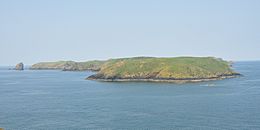
Skomer viewed from Martin's Haven
|
|
| Geography | |
| Location | Jack Sound |
| Coordinates | 51°44′10″N 5°17′47″W / 51.73611°N 5.29628°W |
| Area | 2.92 km2 (1.13 sq mi) |
| Length | 3.2 km (1.99 mi) |
| Width | 2.4 km (1.49 mi) |
| Administration | |
|
Wales
|
|
| County | Pembrokeshire |
| Community | Marloes and St Brides |
Skomer (Welsh: Ynys Sgomer) is a special island found off the coast of Pembrokeshire, in west Wales. It's famous for its amazing wildlife. About half of the world's Manx shearwaters nest here. The island also has the biggest group of Atlantic puffins in southern Britain. Plus, a unique type of bank vole, called the Skomer vole, lives only on this island.
Skomer is a protected place. It's a national nature reserve, a Site of Special Scientific Interest, and a Special Protection Area. The waters around it are also protected as a marine nature reserve. The island is looked after by the Wildlife Trust of South and West Wales.
Skomer is also important for its history. You can find old stone circles, standing stones, and remains of ancient houses. Much of the island is considered an ancient monument.
Contents
About Skomer Island
Skomer Island is about 2.92 square kilometers (1.13 square miles) in size. Its highest point is Gorse Hill, which is 79 meters (259 feet) above the sea. Most of the island is around 60 meters (197 feet) high. Skomer has many slopes and ridges, making its landscape interesting. It is about 2.4 kilometers (1.5 miles) from north to south and 3.2 kilometers (2 miles) from east to west.
The island is almost split in two by two bays on its eastern side. Skomer is one of several islands close to the Pembrokeshire coast. Some smaller islands near Skomer include Midland Isle, Mew Stone, and Garland Stone.
What's in a Name?
The name Skomer comes from an old Viking word, Skalmey. This means "Cleft island." It probably got this name because the eastern part of the island is almost cut off from the main section. An old map from 1578 shows it as Scaline Insul, which might mean "unequal island."
How Skomer Island Formed
The rocks that make up Skomer Island are very old. They were formed about 440 million years ago during the Silurian period. These rocks are mostly volcanic, meaning they came from ancient volcanoes. Some of these rocks, like basalt, even show signs of being formed underwater, like "pillow lava."
Over time, these volcanic rocks were changed by weather and other forces. The island was once connected to the mainland. But after the last Ice Age, sea levels rose. This caused Skomer to become separated from the rest of Wales.
Skomer's Past: A Look at History
People have lived on Skomer for a very long time. There is proof of human settlements and field boundaries from the Iron Age. This means people were living here about 5,000 years ago!
Experts from the Royal Commission for Ancient and Historical Monuments in Wales, along with universities, have been studying the island's ancient communities since 2011. They use special laser scanning and digging to learn more.
Rabbits were brought to the island in the 1300s. Their burrows and grazing have changed the island's landscape a lot.
The last family to live on Skomer all year round was the Codd family, who left in 1950. After the Second World War, the island's owner offered it to a group that later became The Wildlife Trust of South and West Wales. They started looking after Skomer, and it opened to visitors in April 1946. The old farm buildings, where visitors can now stay, were updated in 2005. Skomer was even shown on the BBC TV show Coast in 2010.
David Saunders MBE became Skomer's first warden in 1960.
Amazing Wildlife of Skomer
Skomer is famous for its many seabirds that come to breed. These include Manx shearwaters, guillemots, razorbills, Atlantic puffins, and many types of gulls. You can also spot birds of prey like short-eared owls and peregrine falcons.
The island is also home to grey seals, common toads, and glow-worms. Many beautiful wildflowers grow here too. In the waters around Skomer, you might see harbour porpoises.
Atlantic Puffin: Skomer's Clowns of the Sea
Skomer and nearby Skokholm Island are home to about 10,000 pairs of breeding puffins. This makes them one of the most important puffin places in Britain!
Puffins arrive on Skomer in mid-April to build their nests in burrows. Many of these burrows are dug by the island's large rabbit population. The last puffins leave the island by the end of July. They mostly eat small fish and sand eels. You can often see puffins flying back to their nests with many small eels in their beaks.
After their numbers went down in the past, the puffin population on Skomer is now growing again. By 2020, there were almost 35,000 puffins on the island! They are so used to people that they sometimes run across the paths, not even noticing the tourists.
Manx Shearwater: A Long Journey Home
In 2019, about 350,000 pairs of Manx shearwaters were breeding on Skomer. This is about half of the world's entire population! This makes Skomer and Skokholm the most important breeding sites for these birds. Shearwaters usually nest in rabbit burrows, and a pair often uses the same burrow every year.
It's hard to see shearwaters during the day because they come and go at dusk. But a special camera in one of their burrows lets you watch them on a screen at Lockley Lodge on the mainland. You might also see the remains of shearwaters that have been caught by the island's large great black-backed gulls. If you stay overnight in the hostel on Skomer, you can hear and sometimes see the shearwaters when they are most active.
Manx shearwaters have an amazing life cycle. After they learn to fly, the young birds fly all the way to the South Atlantic, near Brazil and Argentina. They stay at sea for five years before returning to the exact island where they were born to breed. They can even find their way back to within a few meters of their birth burrow!
Because they are clumsy on land, they leave their burrows at dawn to fish far out in the Irish Sea. They don't return until dusk. This helps them avoid gulls, which would easily catch them during the day.
Skomer Vole: A Unique Island Mammal
Skomer has a special mammal found nowhere else: the Skomer vole. This is a unique type of bank vole. Because there are no land predators like foxes or weasels on the island, the bracken plants provide a perfect home for these voles. Their population can reach about 20,000 during the summer. You might see the island's short-eared owls hunting for voles near the farmhouse to feed their young.
Visiting Skomer Island
Boats sail to Skomer from Martin's Haven on the mainland. The trip is about 15 minutes and runs every day except Monday (unless it's a Bank Holiday) from April to September. Boats usually leave between 10 AM and noon. Return trips start from 3 PM.
Only 250 people are allowed to visit the island each day. You can't book tickets in advance. Tickets are given out first-come, first-served at Lockley Lodge in Martin's Haven. Long lines can form early in the morning during busy times.
There is a hostel with 16 beds at the farm in the middle of the island. You can book a stay there by calling the Tondu office, usually starting in October for the next year. Overnight guests take a separate boat trip in the morning. The hostel is open from April to September.
Visitors must stay on marked pathways. The Neck, an eastern part of the island, is completely closed to visitors.
In 2005-2006, the farm buildings were renovated. This included updating the old barn for visitors and researchers, rebuilding the volunteers' living areas, and rebuilding the warden's house at North Haven. Solar power now provides hot water and electricity for lighting.
|
See also
 In Spanish: Skomer para niños
In Spanish: Skomer para niños


